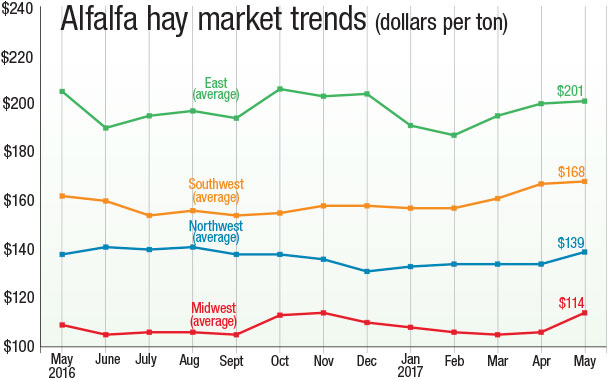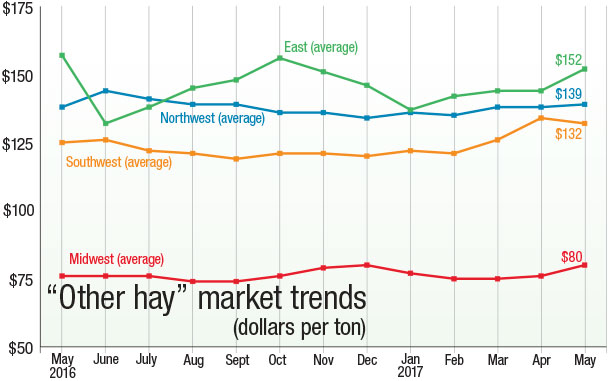The expected harvested area of alfalfa and alfalfa mixtures (at 17.1 million acres) is up 1 percent (226,000 acres) from 2016. All other types of hay harvested are expected to total 36.4 million acres, down less than 1 percent (169,000 acres) from 2016.
Iowa (+200,000 acres of all hay, including +190,000 acres of alfalfa hay), South Dakota (+150,000 acres of all hay) and Missouri (+100,000 acres of all hay) were expected to post the biggest hay acreage increases in 2017.
However, the estimates of planted and harvested acreages were based primarily on surveys conducted during the first two weeks of June. Since then, conditions have deteriorated in major hay-producing areas of North and South Dakota and east Montana.
Based on the June surveys, the biggest declines in alfalfa acreage were expected in Minnesota, where winterkill was heavy, along with Kansas, Montana and Oklahoma. Projected alfalfa acreage in Wisconsin, which also saw heavy winterkill, was unchanged from a year ago.
Northern Plains hard hit by drought
Despite overall good hay-producing conditions across much of the country, the U.S. is not without its trouble spots.
As of July 4, USDA’s World Agricultural Outlook Board said about 11 percent of U.S. hay acreage was located in areas experiencing drought, up about 2 percent from a month earlier. Areas hardest hit were in Montana, North Dakota and South Dakota.
Check out the hay areas under drought conditions.
As a result, the USDA had issued several special natural disaster designations:
Six counties in South Dakota (Campbell, Dewey, Edmunds, McPherson, Potter and Walworth), 15 counties in North Dakota (Adams, Billings, Bowman, Burleigh, Divide, Golden Valley, Hettinger, McLean, Mercer, Morton, Oliver, Slope, Stark, Ward and Williams) and six counties in Montana (Custer, Dawson, Petroleum, Phillips, Prairie, Richland and Rosebud) were designated as primary natural disaster areas due to losses and damages caused by a recent drought.
Producers in contiguous counties of South Dakota (Brown, Corson, Faulk, Haakon, Harding, Hyde, Perkins, Stanley, Sully and Ziebach), North Dakota (Burke, Dickey, Dunn, Emmons, Grant, Kidder, McHenry, McIntosh, McKenzie, Mountrail, Renville, Sheridan and Sioux) and Montana (Fallon, Richland, Roosevelt, Sheridan and Wibaux) also qualify for natural disaster assistance.
In a memo to state and county Farm Service Agency (FSA) offices in Montana, North Dakota and South Dakota on July 1, the USDA further established emergency haying and grazing policies on Conservation Reserve Program (CRP) acreage for affected producers in those states. CRP acreage may be hayed beginning July 16. Proper paperwork must be completed with FSA offices.
Also, 10 Wisconsin counties were designated as primary natural disaster areas due to losses and damages caused by winterkill. Counties included were Brown, Calumet, Kewaunee, La Crosse, Manitowoc, Monroe, Outagamie, Ozaukee, Sheboygan and Washington. Under the designation, producers in another 12 Wisconsin counties (Dodge, Door, Fond du Lac, Jackson, Juneau, Milwaukee, Oconto, Shawano, Trempealeau, Vernon, Waukesha and Winnebago) and two Minnesota counties (Houston and Winona) also qualify for natural disaster assistance because their counties are contiguous.
All qualified farm operators in the designated drought and winterkill areas are eligible for FSA’s emergency (EM) loans, provided eligibility requirements are met. Farmers in eligible counties have eight months from the date of the declaration (June 30) to apply for loans to help cover part of their actual losses.
Alfalfa hay prices
The latest available USDA monthly ag prices report was released June 30, summarizing May 2017 prices.
Alfalfa
The May 2017 U.S. average price paid to alfalfa hay producers at the farm level was $155 per ton, a $7 jump from April and the highest average since October 2015.
On a regional basis, May prices posted the largest increases in the Midwest and Northwest (Figure 1). Within regions, the average price was up $27 per ton in Wisconsin, $16 per ton in South Dakota, $11 per ton in Minnesota and $15 per ton in Washington.

Other hay
The May 2017 U.S. average price for other hay was estimated at $127 per ton, down $5 from April. Regionally, prices for other hay were up in the East (Figure 2), but down slightly in the Southwest. Within regions, average prices for other hay were up $24 per ton in New York and $14 to $17 per ton in Washington, South Dakota and North Dakota.

In the organic hay market, large square bales of Good quality alfalfa sourced from California averaged $260 per ton. The USDA report summarizes organic hay sales held June 22-July 5.
Alfalfa hay exports remain strong
Alfalfa hay exports continued at a strong level. Aided by sales to China, May U.S. alfalfa hay exports topped 268,000 metric tons (MT) for a third consecutive month. China purchased about 117,000 MT, about 43 percent of the monthly total. The alfalfa hay exports were valued at about $76.8 million.
May 2017 sales of other hay totaled just over 116,818 MT, the lowest total since July 2016. Japan and South Korea remained top buyers. The other hay exports were valued at about $35.6 million.
Figures and charts
The prices and information in Figure 1 (alfalfa hay market trends) and Figure 2 (“other hay” market trends) are provided by NASS and reflect general price trends and movements. Hay quality, however, was not provided in the NASS reports. For purposes of this report, states that provided data to NASS were divided into the following regions:
• Southwest – Arizona, California, Nevada, New Mexico, Oklahoma, Texas
• East – Kentucky, New York, Ohio, Pennsylvania
• Northwest – Colorado, Idaho, Montana, Oregon, Utah, Washington, Wyoming
• Midwest – Illinois, Iowa, Kansas, Michigan, Minnesota, Missouri, Nebraska, North Dakota, South Dakota, Wisconsin
Auction and market summaries
Here’s a peek at early July auction market summaries from the USDA’s Ag Marketing Service:
• East: Due to wet conditions over most of the area, Alabama hay prices were steady in limited supply. In Pennsylvania’s Lancaster area, demand was very good, spurred on by light supplies. Large squares of alfalfa-blended hay sold steady. Large squares of grass sold $20 higher. Small squares of alfalfa blends and grass sold $20 to $40 higher.
• Southwest: All Texas hay classes traded steady with instances $5 higher on alfalfa. Movement was slow to moderate during the holiday week. Coastal Bermuda producers were busy in hay fields if weather permitted. Oklahoma alfalfa trade was mostly moderate to active. Demand for Premium alfalfa was moderate to good, but mostly moderate for other grades and offerings. A limited supply of Supreme and Premium quality alfalfa is making locating best quality alfalfa difficult.
• Northwest: Montana hay prices are trending higher with drought conditions worsening. Demand for all hay is good to very good on light supplies. Idaho domestic alfalfa was firm, with very good demand from California presses. Most reported timothy sales are coming into Washington. Oregon prices trended generally steady with not much comparison available from week-ago prices.
In the Washington-Oregon Columbia Basin, new-crop export alfalfa and timothy sold steady to $10 higher. Trade was active, with very good demand, especially for timothy. Utah hay prices were mostly firm, with trading slow. Colorado growers are also reporting large increases in Supreme hay prices compared with last year. Growers are reporting pest problems in the southwest region of the state.
• Midwest: Iowa hay prices trended $5 to $10 lower. In Kansas, hay market activity was slow to moderate; demand was moderate for grinding alfalfa, light for all other classes of hay; and prices were steady to slightly higher. Nebraska round bales of alfalfa were steady to $5 higher; square bales were steady. Buyer inquiry picked up, as some areas of the state are drier than normal. Cattlemen in drought affected regions of South Dakota are considering a possible reduction to their herd size to avoid purchasing supplemental hay.
In southwest Minnesota, there was an adequate supply of hay; price trend is steady with limited quality hay available. In Wisconsin, some areas of the state had greater winter injury than anticipated and has reduced first crop yields. Prices were steady and better quality hay sold at a premium. Overall, weather has not cooperated as wet weather has delayed farmers from completing first crop harvest and second crop has begun. ![]()

-
Dave Natzke
- Editor
- Progressive Forage
- Email Dave Natzke











